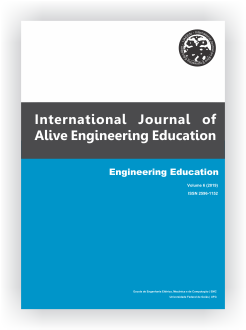Environmental Education and Energy Efficiency as Strategies for Reducing Energy Consumption in Public School Building in Goiânia
DOI:
https://doi.org/10.5216/ijaeedu.v6.54740Abstract
Electrical energy is essential for the quality of life of people, who use it in different socioeconomic activities and for technological development. In view of the gradual increase in the demand for electricity and the future possibility of not serving all the consumer sectors, it is necessary to optimize it. The objective of this study was the application of strategies based on the pillars of energy efficiency and environmental education in order to minimize the expenditure of electric energy in public buildings, which were selected for this project due to the fact that, its users show a lack of concern about the correct consumption of electric energy since the expenses are tied to the public coffers and are not always perceived by the people as resources coming from the taxes paid by the citizens. Among the public buildings that consume the most electric energy, the most important are those in the education sector. In fact, a larger project called the Energy Efficiency Project in Public Buildings in Goiânia (PEEEPG), to which this work is linked, found that among the municipal public buildings, the education sector is responsible for approximately 30% of the electricity consumption and, therefore, this specific sector was selected for the application of the selected strategies. The methodology used was based on research-participant, environmental education together with replacement of lamps by LED system (Light Emitting Diode) at strategic locations in the building and monitoring of results. The actions carried out included the lamp replacement, and educational lectures offered to students of different age groups in three school shifts with a partnership of employees and teachers of the municipal school selected on energy efficiency and strategies to reduce the consumption of electricity. The project mobilized directly about 200 people belonging to the target audience and indirectly 800 students who were part of the teaching unit. It was collected a data base among 2012 to 2016. The methods of data collection and analysis were based on documentary research, analyzing the electric energy bills of the building, as well as documents and legislation of the municipality itself on the consumption of electric power and the architecture model applied to school environments in Goiânia. The results obtained, after a monitoring period of six months (November to April) during the years 2016 and 2017, indicated an analyze to reduction of 16% of the consumption of electric energy in the building, compared to the same period in the previous year. Therefore, this result regard to the possibility of investments in energy efficiency projects for public buildings, subsidizing actions in the design, retrofit and maintenance of public buildings.
References
MENKES, Mônica. Eficiência Energética, Políticas Públicas e Sustentabilidade. Brasília. 2004.
BRANCO, S. M. Energia e meio ambiente. São Paulo: Moderna, 1990.
CAMACHO, M. A. da Gama. Modelo para Implantação e Acompanhamento de Programa Corporativo de Gestão de Energia. Tese de Mestrado. Campina Grande, UFCG, 2009.
GARCIA, A.G.P. Leilão de Eficiência Energética no Brasil. Tese de Doutorado, Universidade Federal do Rio de Janeiro – COOPE/UFRJ, 2008, 186 p.
TOLMASQUIM, M. T. Perspectivas e planejamento do setor energético no Brasil. Estudos avançados, v. 26, n. 74, p. 249-260. 2012.
LAMBERTS, Roberto; DUTRA, Luciano; PEREIRA, Fernando O. R. Eficiência energética na arquitetura. 3ª ed. São Paulo: PW Editores, 2014.
BRASIL. Balanço Energético Nacional 2017: Ano base 2016 / Empresa de Pesquisa Energética. Rio de Janeiro: EPE, 2017. Disponível em: <https://ben.epe.gov.br/downloads/Relatorio_Final_BEN_2017.pdf>. Acesso em: 10 de dezembro de 2017.
SOUZA, H. et al. Reflexões Sobre Os Principais Programas Em Eficiência Energética Existentes No Brasil. Revista Brasileira de Energia, Vol. 15, No. 1, 1o Sem. 2009, p. 7-26.
PROCEL, Programa Nacional de Conservação de Energia Elétrica. Relatório de resultados do Procel 2016 - ano base 2015. Rio de Janeiro, 2016.
EMPRESA DE PESQUISA ENERGÉTICA – EPE.Resenha Mensal do Mercado de Energia Elétrica, ano IX, nº 100, Janeiro de 2016,.
Didoné et al.. Estratégias para edifícios de escritórios energia zero no Brasil com ênfase em BIPV. 2014
CELG – COMPANHIA ENERGÉTICA DE GOIÁS – Disponível em: <https://www.celg.com.br/>. Acesso em: 17 de abril de 2016.
INSTITUTO BRASILEIRO DE GEOGRAFIA E ESTATÍSTICA – IBGE. Disponível em: <http://www.ibge.gov.br/>. Acesso em: 02 jul 2016.
HORA, Karla et al. Relatórios Técnicos. Eficiência energética de edifícios públicos em Goiânia. Goiânia, Goiás, Brasil. Dezembro. 2015/2016.
DEMO, Pedro. Metodologia científica em Ciências Sociais. São Paulo: Atlas, 1995.
Downloads
Published
Issue
Section
License
Copyright
The author is responsible for the following statements by submitting an article electronically in the International Journal of Alive Engineering Education (IJAEEdu):
a) States that the document in question was reviewed by an expert in English language and it is an original work and it holds the prerogative to grant the rights contained in this license. It also states that the document does not infringe, as far as it is possible to know the rights of any other person or entity.
b) If the document in question contains material which does not hold the copyright, the author states have obtained the copyright holder’s permission to grant the Universidade Federal de Goiás (UFG) the rights required by this license, and that such material whose rights are third is clearly identified and acknowledged within the text or content of the document.
c) States that the study was conducted in accordance with the ethical standards of all applicable institutional, local, national and international guidelines.
d) It also states that any person appointed as author or co-author of the document is aware of it and agrees to be so appointed.
Authorization Form
As responsible for the submission of the document, I authorize the School of Electrical, Mechanical and Computer Engineering of the Federal University of Goiás to provide the paper free of charge, through the Electronic System for Publishing Magazines UFG (SEER / UFG) or in printed form, without compensation of copyright, in accordance with Law No. 9610/98. Is allowed, reading, printing and / or download, as a promotion of the Brazilian scientific production. Any use of the work not authorized under this license or the copyright law is prohibited.



